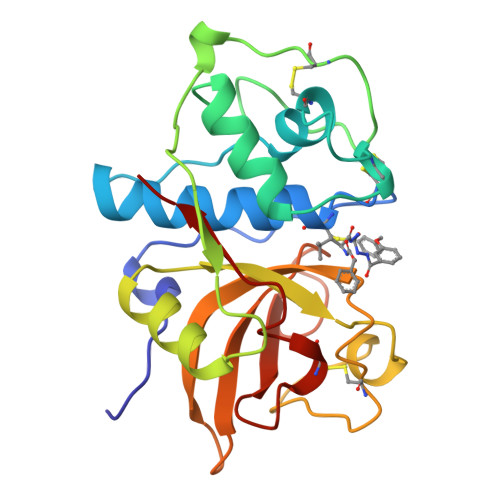Design of potent and selective human cathepsin K inhibitors that span the active site.
Thompson, S.K., Halbert, S.M., Bossard, M.J., Tomaszek, T.A., Levy, M.A., Zhao, B., Smith, W.W., Abdel-Meguid, S.S., Janson, C.A., D'Alessio, K.J., McQueney, M.S., Amegadzie, B.Y., Hanning, C.R., DesJarlais, R.L., Briand, J., Sarkar, S.K., Huddleston, M.J., Ijames, C.F., Carr, S.A., Garnes, K.T., Shu, A., Heys, J.R., Bradbeer, J., Zembryki, D., Lee-Rykaczewski, L., James, I.E., Lark, M.W., Drake, F.H., Gowen, M., Gleason, J.G., Veber, D.F.(1997) Proc Natl Acad Sci U S A 94: 14249-14254
- PubMed: 9405598
- DOI: https://doi.org/10.1073/pnas.94.26.14249
- Primary Citation of Related Structures:
1AYU, 1AYV, 1AYW - PubMed Abstract:
Potent and selective active-site-spanning inhibitors have been designed for cathepsin K, a cysteine protease unique to osteoclasts. They act by mechanisms that involve tight binding intermediates, potentially on a hydrolytic pathway. X-ray crystallographic, MS, NMR spectroscopic, and kinetic studies of the mechanisms of inhibition indicate that different intermediates or transition states are being represented that are dependent on the conditions of measurement and the specific groups flanking the carbonyl in the inhibitor. The species observed crystallographically are most consistent with tetrahedral intermediates that may be close approximations of those that occur during substrate hydrolysis. Initial kinetic studies suggest the possibility of irreversible and reversible active-site modification. Representative inhibitors have demonstrated antiresorptive activity both in vitro and in vivo and therefore are promising leads for therapeutic agents for the treatment of osteoporosis. Expansion of these inhibitor concepts can be envisioned for the many other cysteine proteases implicated for therapeutic intervention.
Organizational Affiliation:
Department of Medicinal Chemistry, SmithKline Beecham Pharmaceuticals, King of Prussia, PA 19406, USA.

















